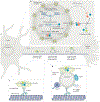The functional organization of axonal mRNA transport and translation
- PMID: 33288912
- PMCID: PMC8161363
- DOI: 10.1038/s41583-020-00407-7
The functional organization of axonal mRNA transport and translation
Abstract
Axons extend for tremendously long distances from the neuronal soma and make use of localized mRNA translation to rapidly respond to different extracellular stimuli and physiological states. The locally synthesized proteins support many different functions in both developing and mature axons, raising questions about the mechanisms by which local translation is organized to ensure the appropriate responses to specific stimuli. Publications over the past few years have uncovered new mechanisms for regulating the axonal transport and localized translation of mRNAs, with several of these pathways converging on the regulation of cohorts of functionally related mRNAs - known as RNA regulons - that drive axon growth, axon guidance, injury responses, axon survival and even axonal mitochondrial function. Recent advances point to these different regulatory pathways as organizing platforms that allow the axon's proteome to be modulated to meet its physiological needs.
Conflict of interest statement
Competing interests
J,L.T. and P.K.S. have a US Patent for G3BP1 as a target for accelerating axon regeneration (US Patent 10,668,128). A.N.K., P.K.S. and J.L.T. have applied for a US patent for G3BP1 as a target for preventing neurodegeneration.
Figures




References
-
- Steward O & Schuman EM Protein synthesis at synaptic sites on dendrites. Annu. Rev. Neurosci 24, 299–325 (2001). - PubMed
-
- Kosik KS Life at low copy number: how dendrites manage with so few mRNAs. Neuron 92, 1168–1180 (2016). - PubMed
-
- Tobias G & Koenig E Axonal protein synthesizing activity during the early outgrowth period following neurotomy. Exp. Neurol 49, 221–234 (1975). - PubMed
Publication types
MeSH terms
Substances
Grants and funding
LinkOut - more resources
Full Text Sources
Other Literature Sources
Miscellaneous

